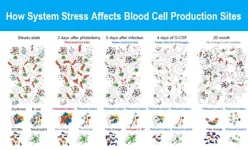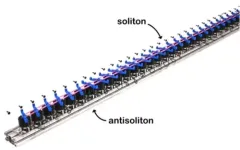(Press-News.org) Research Highlights:
Exposure to tobacco before birth and beginning smoking during childhood or adolescence were significantly associated with the development of Type 2 diabetes in adulthood, according to a study of nearly half a million adults in the UK Biobank.
Among those exposed to tobacco before birth or who began smoking during childhood or adolescence, participants who had a genetic predisposition to develop Type 2 diabetes and started smoking in childhood or adolescence had the highest risk of developing Type 2 diabetes.
Embargoed until 10:30 a.m. CT/11:30 a.m. ET, Wednesday, March 20, 2024
CHICAGO, March 20, 2024 — Tobacco exposure before birth and beginning smoking during childhood/adolescence were significantly associated with the development of Type 2 diabetes in adulthood, especially for people with a high genetic risk of Type 2 diabetes, according to preliminary research to be presented at the American Heart Association’s Epidemiology and Prevention│Lifestyle and Cardiometabolic Scientific Sessions 2024, March 18- 21, in Chicago. The meeting offers the latest science on population-based health and wellness and implications for lifestyle.
Tobacco exposure in adulthood is a well-established risk factor for Type 2 diabetes, and previous research has found that people who smoke cigarettes are 30%–40% more likely to develop Type 2 diabetes than people who don’t smoke.
“However, how early-life tobacco exposure may impact the development of Type 2 diabetes, as well as whether this association varies by different genetic predisposition to Type 2 diabetes are unclear,” said senior study author Victor Wenze Zhong, Ph.D., a professor and chair of the department of epidemiology and biostatistics at Shanghai Jiao Tong University School of Medicine in Shanghai, China.
In this study, researchers reviewed data for almost 476,000 adults in the UK Biobank to estimate the associations of tobacco exposure before birth and beginning smoking during childhood (ages 5-14) or adolescence (ages 15-17) with the development of Type 2 diabetes. A polygenic risk score for Type 2 diabetes was used to assess the possible interactions and joint effects between early-life tobacco exposure and genetic susceptibility on the development of Type 2 diabetes.
The researchers also investigated whether adherence to a healthy lifestyle as an adult, such as eating a healthy diet, exercising, getting sufficient sleep, maintaining normal weight and not smoking may have affected the development of Type 2 diabetes among high-risk individuals.
The analysis found:
Early-life tobacco exposure, before birth and/or beginning to smoke in childhood or adolescence, were significantly associated with the development of Type 2 diabetes, with a higher risk for individuals with a genetic predisposition for the condition.
Tobacco exposure before birth was associated with a 22% increased risk of developing Type 2 diabetes compared to people who never smoked.
People who started smoking in childhood had double the risk of Type 2 diabetes; those who started smoking as adolescents had a 57% higher risk, while those who started smoking as adults had a 33% higher risk of developing Type 2 diabetes compared to those who never smoked.
Compared with participants having no early-life tobacco exposure and a low genetic predisposition for Type 2 diabetes, people with a high genetic risk score had a 330% higher risk of developing Type 2 diabetes if they were also exposed to tobacco before birth, a 639% higher risk if they started smoking in childhood and a 427% higher risk if they started smoking in adolescence.
This increased risk of Type 2 diabetes due to early-life tobacco exposures and high genetic risk was reduced by 67% to 81% among individuals who followed a healthy lifestyle in later life compared to individuals who did not.
“Although early-life tobacco exposure and genetic predisposition are not things children can control, our results provide evidence that lifestyle factors may powerfully modify the risk of Type 2 diabetes. It’s important for individuals, particularly those exposed to tobacco early in life and with a high genetic risk of Type 2 diabetes, to adhere to a healthy lifestyle to reduce their risk of developing Type 2 diabetes as adults,” Zhong said. “While our study identified an association between early life tobacco exposure and Type 2 diabetes, this does not mean that tobacco exposure definitively caused Type 2 diabetes.”
Study background and details:
The UK Biobank is a large biomedical database and research resource with health records of about 500,000 adults — enrolled from 2006 until 2010 — who live in the U.K and received health care through the U.K.’s National Health Service. In January 2023, the researchers accessed the data, which had been last updated in November 2022.
The study included 475,957 participants who did not have Type 2 diabetes when they enrolled. 23,480 people developed Type 2 diabetes during the median follow-up time of 14.6 years.
The mean age of participants at time of enrollment in the UK Biobank was 56.2 years old.
At the time of enrollment, 55.7% of participants analyzed for this study self-identified as women; 44.3% self-identified as men. 90.8% of participants included in the study self-identified as white; 9.8% self-identified as other.
The study had several limitations. It is an observational study, meaning the findings indicate an association and do not confirm direct cause and effect. Information about tobacco exposure was self-reported by participants, therefore, the data may include possible errors in memory. In addition, there was the potential presence of other unmeasured sources of early-life tobacco exposure (such as second- and/or third-hand tobacco exposure in early life, including long-lingering residues in dwellings and on surfaces). Finally, more than 90% of the study population from the UK Biobank self-identified as white, meaning the findings are not generalizable to people of other races or ethnicities.
“Tobacco use by adults is hazardous for many health outcomes, including cancer, cardiovascular disease, Type 2 diabetes and other complications. However, for new-onset Type 2 diabetes in adults, the timing of tobacco exposure and a diagnosis of Type 2 diabetes has not been elucidated, nor has the contribution of multiple genes or polygenic risk for Type 2 diabetes been assessed,” said Robert H. Eckel, M.D., FAHA, a past president (2005-2006) of the American Heart Association, who was not involved in the study.
“When participants who had no early-life tobacco exposure and a low polygenic risk score were compared to those with a high polygenic risk score, an alarming escalation of risk for developing T2D was seen in utero, in childhood and in adolescence,” said Eckel, a professor emeritus of medicine in the Division of Endocrinology, Metabolism and Diabetes and the Division of Cardiology and the Charles A. Boettcher Endowed Chair in Atherosclerosis at the University of Colorado Anschutz Medical Campus. “As with all observational data, validation is needed, and causation was not proven, however, the Association continues to strongly recommend abstinence from tobacco exposure throughout life.”
Co-authors, their disclosures and funding sources are listed in the abstract.
Statements and conclusions of studies that are presented at the American Heart Association’s scientific meetings are solely those of the study authors and do not necessarily reflect the Association’s policy or position. The Association makes no representation or guarantee as to their accuracy or reliability. Abstracts presented at the Association’s scientific meetings are not peer-reviewed, rather, they are curated by independent review panels and are considered based on the potential to add to the diversity of scientific issues and views discussed at the meeting. The findings are considered preliminary until published as a full manuscript in a peer-reviewed scientific journal.
The Association receives funding primarily from individuals; foundations and corporations (including pharmaceutical, device manufacturers and other companies) also make donations and fund specific Association programs and events. The Association has strict policies to prevent these relationships from influencing the science content. Revenues from pharmaceutical and biotech companies, device manufacturers and health insurance providers and the Association’s overall financial information are here.
Additional Resources:
Multimedia is available on the right column of the release link https://newsroom.heart.org/news/exposure-to-tobacco-before-birth-significantly-increased-risk-of-type-2-diabetes-in-adults?preview=358ad14a72b8fbc3535b0acdce3c6391
After March 20, view abstract 30 in the EPI│Lifestyle Scientific Sessions 2024 Online Program Planner.
AHA news release: Delay of lifesaving tobacco rules will jeopardize the health of communities (Dec. 2023)
AHA news release: Prediabetes and persistent tobacco use may triple risk of stroke in healthy young adults (Nov. 2023)
AHA news release: New FDA/CDC data show troubling levels of youth e-cigarette use (Oct. 2022)
AHA Presidential Advisory: New and Emerging Tobacco Products and the Nicotine Endgame
For more news from AHA EPI│Lifestyle Scientific Sessions 2024, follow us on X (formerly known as Twitter) @HeartNews, #EPILifestyle24.
###
The American Heart Association’s EPI│Lifestyle Scientific Sessions 2024 is the world’s premier meeting dedicated to the latest advances in population-based science. The 2024 meeting is in-person only, Monday through Thursday, March 18-21 at the Hilton Chicago. The primary goal of the meeting is to promote the development and application of translational and population science to prevent heart disease and stroke and foster cardiovascular health. The sessions focus on risk factors, obesity, nutrition, physical activity, genetics, metabolism, biomarkers, subclinical disease, clinical disease, healthy populations, global health and prevention-oriented clinical trials. The Councils on Epidemiology and Prevention and Lifestyle and Cardiometabolic Health (Lifestyle) jointly planned the EPI│Lifestyle Scientific Sessions 2024. Follow the conference on Twitter at #EPILifestyle24.
About the American Heart Association
The American Heart Association is a relentless force for a world of longer, healthier lives. We are dedicated to ensuring equitable health in all communities. Through collaboration with numerous organizations, and powered by millions of volunteers, we fund innovative research, advocate for the public’s health and share lifesaving resources. The Dallas-based organization has been a leading source of health information for a century. During 2024 - our Centennial year - we celebrate our rich 100-year history and accomplishments. As we forge ahead into our second century of bold discovery and impact, our vision is to advance health and hope for everyone, everywhere. Connect with us on heart.org, Facebook, X or by calling 1-800-AHA-USA1.
END
Exposure to tobacco before birth significantly increased risk of Type 2 diabetes in adults
American Heart Association Epidemiology and Prevention│Lifestyle and Cardiometabolic Health Scientific Sessions 2024, Abstract 30
2024-03-20
ELSE PRESS RELEASES FROM THIS DATE:
In flies, a single brain cell can drive multiple movements of the body
2024-03-20
NEW YORK, NY — Motor neurons are the cells the brain uses to command muscles to act. Scientists typically thought of them as simple connections, much like the cables that link computers with their accessories. Now, in fly studies, researchers at Columbia's Zuckerman Institute have discovered that single motor neurons can each direct an insect’s body to move in far more complex ways than previously thought.
The findings were published in Nature on March 20.
"This is one of the first times scientists have analyzed in 3D what single motor neurons do ...
Toba supereruption unveils new insights into early human migration
2024-03-20
Modern humans dispersed from Africa multiple times, but the event that led to global expansion occurred less than 100,000 years ago. Some researchers hypothesize that dispersals were restricted to “green corridors” formed during humid intervals when food was abundant and human populations expanded in lockstep with their environments. But a new study in Nature, including ASU researchers Curtis Marean, Christopher Campisano, and Jayde Hirniak, suggests that humans also may have dispersed during arid intervals along “blue highways” created by seasonal rivers. Researchers also found evidence of cooking and stone tools that represent the oldest evidence of archery.
Working ...
Bacteria subtype linked to growth in up to 50% of human colorectal cancers, Fred Hutch researchers report
2024-03-20
Researchers at Fred Hutchinson Cancer Center have found that a specific subtype of a microbe commonly found in the mouth is able to travel to the gut and grow within colorectal cancer tumors. This microbe is also a culprit for driving cancer progression and leads to poorer patient outcomes after cancer treatment.
The findings, published March 20 in the journal Nature, could help improve therapeutic approaches and early screening methods for colorectal cancer, which is the second most common cause of cancer deaths in adults in the U.S. according to the American Cancer Society.
Examining colorectal cancer tumors removed from ...
Reducing the side effects of breast and ovarian cancer treatment
2024-03-20
Some anti-cancer treatments not only target tumour cells but also healthy cells. If their effects on the latter are too strong, their use can become limiting. A team from the University of Geneva (UNIGE), in collaboration with Basel-based FoRx Therapeutics, has identified the mechanism of action of PARP inhibitors, used in particular for breast and ovarian cancer in patients carrying the BRCA gene mutation. These inhibitors block two specific activities of the PARP proteins. By blocking one of them, the toxic effect on cancer cells is maintained, while healthy cells are preserved. This work, published in the journal Nature, will help improve the efficacy of these treatments.
Despite ...
Skeleton-wide study of blood cell formation yields surprising findings
2024-03-20
Imagine being able to count the different types of blood cells being formed inside the tiny bones of a mouse and pinpointing the strings and clusters of cells within the bone marrow that are responsible for producing specific types of blood cells.
That’s exactly what a team of scientists led by experts at Cincinnati Children’s achieved in a far-reaching study published March 20, 2024, in the prestigious journal Nature. Their work adds unprecedented new understanding of the “elegant” and “resilient” anatomy of bone marrow while also generating evidence of unexpected variations in how the skeleton ...
MD Anderson Research Highlights for March 20, 2024
2024-03-20
HOUSTON ― The University of Texas MD Anderson Cancer Center’s Research Highlights showcases the latest breakthroughs in cancer care, research and prevention. These advances are made possible through seamless collaboration between MD Anderson’s world-leading clinicians and scientists, bringing discoveries from the lab to the clinic and back.
Recent developments at MD Anderson offer insights into a combination therapy that slows pancreatic cancer progression, an all-oral treatment for older patients with acute myeloid leukemia (AML) unable to receive intensive chemotherapy, novel targets to protect against osteoporosis and bone metastasis, the generation ...
An endless domino effect
2024-03-20
If it walks like a particle, and talks like a particle… it may still not be a particle. A topological soliton is a special type of wave or dislocation which behaves like a particle: it can move around but cannot spread out and disappear like you would expect from, say, a ripple on the surface of a pond. In a new study published in Nature, researchers from the University of Amsterdam demonstrate the atypical behaviour of topological solitons in a robotic metamaterial, something which in the future may be used to control how robots move, sense their surroundings and communicate.
Topological solitons can be found in many ...
ARPA-H appoints Etta Pisano to lead its Advancing Clinical Trials Readiness Initiative
2024-03-20
The Advanced Research Projects Agency for Health (ARPA-H) has appointed Etta D. Pisano, MD, FACR, senior portfolio lead, to build the agency's clinical trial portfolio and lead the ARPA-H Advancing Clinical Trials Readiness Initiative under ARPA-H Resilient Systems Mission Office Director Jennifer Roberts.
The first radiologist to be appointed to such a role, Dr. Pisano is an internationally recognized expert in women's health, breast cancer research, and the use of artificial intelligence in ...
Quantum tornado provides gateway to understanding black holes
2024-03-20
Scientists have for the first time created a giant quantum vortex to mimic a black hole in superfluid helium that has allowed them to see in greater detail how analogue black holes behave and interact with their surroundings.
Research led by the University of Nottingham, in collaboration with King’s College London and Newcastle University, have created a novel experimental platform: a quantum tornado. They have created a giant swirling vortex within superfluid helium that is chilled to the lowest possible temperatures. Through the observation of minute wave dynamics on the superfluid’s surface, the research team has shown that these quantum ...
Introducing Floorlocator: a game-changer in indoor navigation technology
2024-03-20
Researchers have developed FloorLocator, a breakthrough in indoor navigation technology, which combines the high efficiency of Spiking Neural Networks (SNNs) with the advanced learning capabilities of Graph Neural Networks (GNNs). This innovative approach ensures remarkable accuracy and scalability for floor localization, crucial for enhancing emergency responses, indoor positioning, and personalized recommendation systems.
Indoor positioning is transforming with applications demanding precise location tracking. Traditional methods, including fingerprinting and sensor-based techniques, though widely used, face significant drawbacks such as the ...
LAST 30 PRESS RELEASES:
Low daily alcohol intake linked to 50% heightened mouth cancer risk in India
American Meteorological Society announces Rick Spinrad as 2026 President-Elect
Biomass-based carbon capture spotlighted in newly released global climate webinar recording
Illuminating invisible nano pollutants: advanced bioimaging tracks the full journey of emerging nanoscale contaminants in living systems
How does age affect recovery from spinal cord injury?
Novel AI tool offers prognosis for patients with head and neck cancer
Fathers’ microplastic exposure tied to their children’s metabolic problems
Research validates laboratory model for studying high-grade serous ovarian cancer
SIR 2026 delivers transformative breakthroughs in minimally invasive medicine to improve patient care
Stem Cell Reports most downloaded papers of 2025 highlight the breadth and impact of stem cell research
Oxford-led study estimates NHS spends around 3% of its primary and secondary care budget on the health impacts of heat and cold in England
A researcher’s long quest leads to a smart composite breakthrough
Urban wild bees act as “microbial sensors” of city health.
New study finds where you live affects recovery after a hip fracture
Forecasting the impact of fully automated vehicle adoption on US road traffic injuries
Alcohol-related hospitalizations from 2016 to 2022
Semaglutide and hospitalizations in patients with obesity and established cardiovascular disease
Researchers ‘listen in’ to embryo-mother interactions during implantation using a culture system replicating the womb lining
How changing your diet could help save the world
How to make AI truly scalable and reliable for real-time traffic assignment?
Beyond fragmented markets: A new framework for efficient and stable ride-pooling
Can shape priors make road perception more reliable for autonomous driving?
AI tracks nearly 100 years of aging research, revealing key trends and gaps
Innovative techniques enable Italy’s first imaging of individual trapped atoms
KIER successfully develops Korea-made “calibration thermoelectric module” for measuring thermoelectric device performance
Diversifying US Midwest farming for stability and resilience
Emphasizing immigrants’ deservingness shifts attitudes
Japanese eels, climate change, and river temperature
Pusan National University researchers discover faster, smarter heat treatment for lightweight magnesium metals
China’s 2024 Gastroenterology Report: marked progress in endoscopy quality and disease management
[Press-News.org] Exposure to tobacco before birth significantly increased risk of Type 2 diabetes in adultsAmerican Heart Association Epidemiology and Prevention│Lifestyle and Cardiometabolic Health Scientific Sessions 2024, Abstract 30







